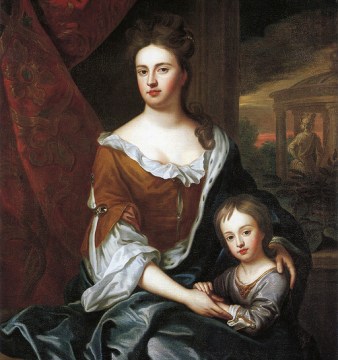“It shuffled the leadership of royal houses like a handful of playing cards.” So says writer Maryn McKenna of smallpox. (See my previous post.)
Her National Geographic article revealed that DNA from a young Lithuanian girl’s mummy is rewriting smallpox history.
And the disease shuffling dynasties?
Let’s take a look.
A Roll Call of Royal Smallpox Deaths
In Britain
Queen Elizabeth I survived smallpox, but many who came after her in England’s royal line did not.
These three died of smallpox in their twenties, all within about a decade of each other in the mid-1600s:
- Princess Mary of England
- Her husband William II of Orange
- Her brother Duke of Gloucester
Smallpox deaths in the next generation:
- Queen Mary II (joint monarch with her husband and first cousin, William III of Orange)
- Two of Queen Mary’s younger brothers, James and Charles (died in childhood)
- Mary (daughter of Queen Mary’s sister Queen Anne, died just short of age two)
- William, Duke of Gloucester, son of Queen Anne (died days after his 11th birthday, cause of death is disputed but many historians describe hemorrhagic smallpox)

With no surviving heir to the House of Stuart when Anne died in 1714, the House of Hanover ascended the English throne (Hanoverian prince George Louis–King George I).
In Austria
Eleven members of the reigning House of Hapsburg died of smallpox between 1654 and 1767, causing four shifts in the line of succession.
In France
- Louis XIV’s heir, the grand dauphin, died of smallpox in 1711
- Louis XV died of smallpox after a 59-year reign, just before the French Revolution
SMALLPOX SHUFFLING POPULATIONS
Epidemics & Pandemics in the 1700s
Smallpox became endemic (commonly occurring) in Asia, the Indian subcontinent, Africa, the islands of the Western Pacific, Europe and the Americas.
It sometimes broke out in terrible epidemics.
UK & Europe
- Five major epidemics in London between 1719 and 1746 (thousands of deaths in each epidemic, mostly children)
- Similar epidemics in Geneva, Berlin, Rome and other cities in Europe
India: 3,000,000 Dead in One State
- Multiple sweeping smallpox pandemics in India, including three million dead in one pandemic alone in Bengal state
Other epidemics in the 1700s
- Epidemic in Sumatra
- Pandemic throughout South America
- Khoikhoi tribe–decimated by smallpox in South Africa (The surviving 10% became known as Hottentots.)
A TALE OF TWO MARYS
More about Queen Mary II
Early in December 1694 an assassin emerged from the streets of London to sneak westward across the park, slip unseen through the halls of Kensington Palace, and attack the beautiful and beloved young queen.
Six years before, it had taken a revolution to put Mary and her Dutch husband, William of Orange, on the British throne, but on this wintry day her attacker was…[n]othing more than a tiny protein-coated and exuberantly proliferant tangle of DNA…’The small pox,’ the English called it, to distinguish it from ‘the great pox,’ syphilis, whose strange rashes it sometimes mimicked. The Speckled Monster: A Historical Tale of Battling Smallpox by Jennifer Lee Carrell
In her book, Carrell describes in heartbreaking detail the course of the queen’s fatal illness–late hemorrhagic smallpox. And finally her death on December 28, 1694, at age thirty-two.
Lady Mary Wortley Montagu
Legendary Beauty
Lady Mary was an intelligent and vivacious young woman who moved easily in the circles of London’s intellectuals, artists and poets. She was a regular at court and a favorite guest of King George I at his supper parties.
Even as a young girl of ten or twelve, her beauty, quick mind and clever verse had conquered the hearts of the members of her father’s Kit-Cat club. Jennifer Lee Carrell says she was “tiny and fine-boned as a wren, with dark hair and dark eyes that sparkled with precocious intelligence….”

Beauty Stolen
Ignoring Lady Mary’s gifts and social triumphs, smallpox came calling.
The disease burned through her on its horrifying and disfiguring path, but spared her life. After her first post-smallpox look at her unrecognizable face, she set down the hand mirror and took up the pen. She poured onto the page feelings about, “…a frightful spectre to myself unknown.”
Undefeated and undaunted, Lady Mary used a silk mask to hide her scarred face when guests came to call. Nothing would hide her sparkling wit, and her exuberant independent spirit would revive soon enough.
First Lady of the Embassy
While her husband was later serving as Britain’s ambassador to the Ottoman Empire, she observed that some in Constantinople (Istanbul) seemed to be immune to smallpox. She investigated, and documented. And then—
took an enormous risk.

She had her young son, Edward, variolated.
Check back in an upcoming post for more about that risk, its outcome, and her campaign to contain smallpox in England.
Thank you for reading my blog and visiting my other website pages. I hope the information may fill in some gaps in what you already knew about smallpox.
All the details were so interesting and relevant. Have you added some of this to your book or is it already in the process?
Some of it was already in my book. : )
What a chilling survey of smallpox’s historical effects. You show us through two lenses: royal individuals in western Europe, and millions of people in South America, India and elsewhere around the world. What a powerful game-changer a pathogen can be!
It’s been said that smallpox killed more people than all the wars in history combined. Just imagine if you combined all pathogen-caused changes in the balance of power between tribes or between nations.